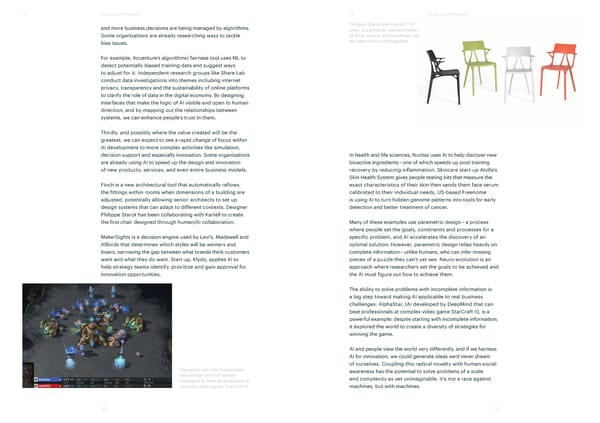T5 Designing intelligence T5 Designing intelligence and more business decisions are being managed by algorithms. Philippe Starck and Kartell’s “A.I” chair is a physical representation Some organizations are already researching ways to tackle of what people and machines can bias issues. do when they work together. For example, Accenture’s algorithmic fairness tool uses ML to detect potentially biased training data and suggest ways to adjust for it. Independent research groups like Share Lab conduct data investigations into themes including internet privacy, transparency and the sustainability of online platforms to clarify the role of data in the digital economy. By designing interfaces that make the logic of AI visible and open to human direction, and by mapping out the relationships between systems, we can enhance people’s trust in them. Thirdly, and possibly where the value created will be the greatest, we can expect to see a rapid change of focus within AI development to more complex activities like simulation, decision support and especially innovation. Some organizations In health and life sciences, Nuritas uses AI to help discover new are already using AI to speed up the design and innovation bioactive ingredients – one of which speeds up post-training of new products, services, and even entire business models. recovery by reducing inflammation. Skincare start-up Atolla’s Skin Health System gives people testing kits that measure the Finch is a new architectural tool that automatically reflows exact characteristics of their skin then sends them face serum the fittings within rooms when dimensions of a building are calibrated to their individual needs. US-based Freenome adjusted, potentially allowing senior architects to set up is using AI to turn hidden genome patterns into tools for early design systems that can adapt to different contexts. Designer detection and better treatment of cancer. Philippe Starck has been collaborating with Kartell to create the first chair designed through human/AI collaboration. Many of these examples use parametric design – a process where people set the goals, constraints and processes for a MakerSights is a decision engine used by Levi’s, Madewell and specific problem, and AI accelerates the discovery of an Allbirds that determines which styles will be winners and optimal solution. However, parametric design relies heavily on losers, narrowing the gap between what brands think customers complete information – unlike humans, who can infer missing want and what they do want. Start-up, Klydo, applies AI to pieces of a puzzle they can’t yet see. Neuro-evolution is an help strategy teams identify, prioritize and gain approval for approach where researchers set the goals to be achieved and innovation opportunities. the AI must figure out how to achieve them. The ability to solve problems with incomplete information is a big step toward making AI applicable to real business challenges. AlphaStar, (AI developed by DeepMind that can beat professionals at complex video game StarCraft II), is a powerful example: despite starting with incomplete information, it explored the world to create a diversity of strategies for winning the game. AI and people view the world very differently, and if we harness AI for innovation, we could generate ideas we’d never dream of ourselves. Coupling this radical novelty with human social AlphaStar can take incomplete awareness has the potential to solve problems of a scale information and still devise and complexity as yet unimaginable. It’s not a race against strategies to beat professionals at complex video game, StarCraft II. machines, but with machines. 69 70
 xReport Page 39 Page 41
xReport Page 39 Page 41